Best Trombone Players Of All Times: A Top 18+ Countdown

The trombone makes many beautiful sounds in jazz music. Many skilled trombone players have made this instrument shine. Let’s look at 18+ top trombone stars who changed music forever.
This post shares 18+ famous trombone players of all time. Each player (like J.J. Johnson and Tommy Dorsey) brought something special to the trombone.
We’ll explore why these jazz stars matter and how they helped make the trombone important in jazz.
Jack Teagarden
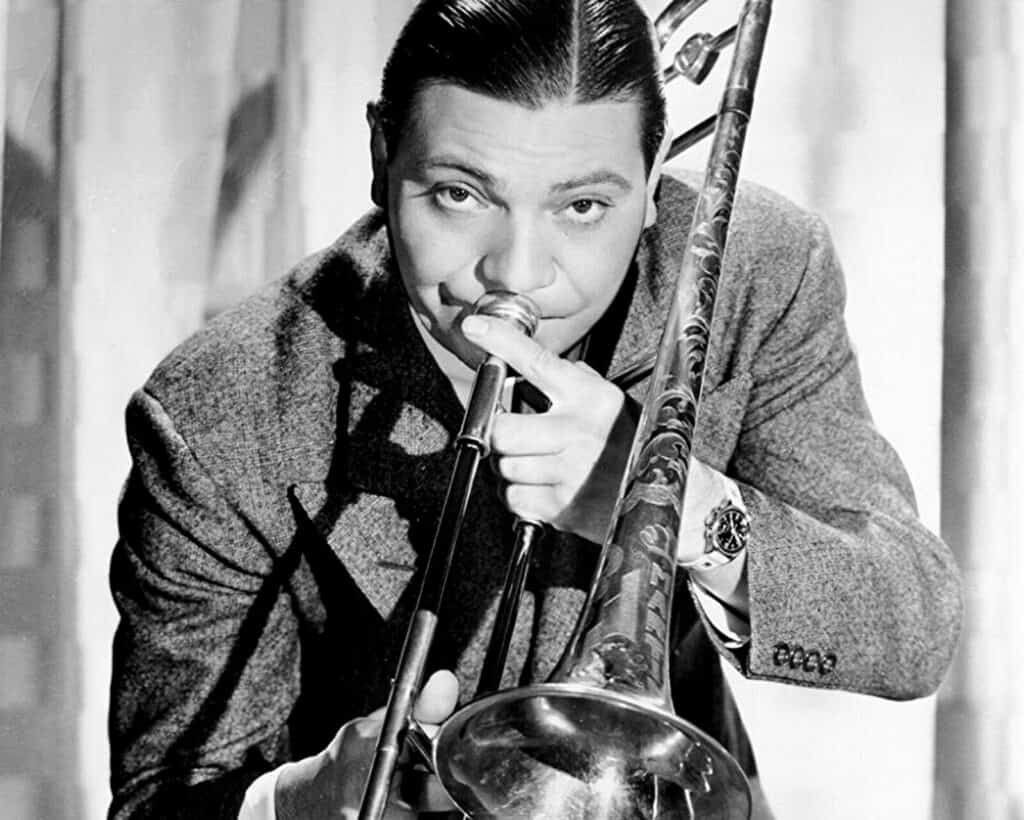
Facts:
- August 20, 1905 – January 15, 1964
- Genres: Jazz, swing, big band
- Instruments: trombone, baritone, vocalist
- Appeared in 39 short films
- Patented trombone spit valve
- Awards:
- Metronome trombone poll winner, 1939
- Esquire Gold Award, 1943
- Playboy Trombone Awards, 1957-58, 1960
Jack Teagarden was born into a family of musicians in Vernon, Texas. At four years old, his father pushed him to play the baritone horn. But Jack switched to the trombone when he was seven years old.
He began playing with his mother (who played piano) in movie theaters. Jack’s brother and sister also became pro musicians and did well.
Mr. Teagarden was one of the most famous trombone players who mainly taught himself. He created many new finger positions on the trombone. Because his arms were shorter than other trombone players, he didn’t use the common style of that time.
Instead, he made many notes by mastering his mouth position. He adapted the first four slide positions to make all the sounds needed in jazz.
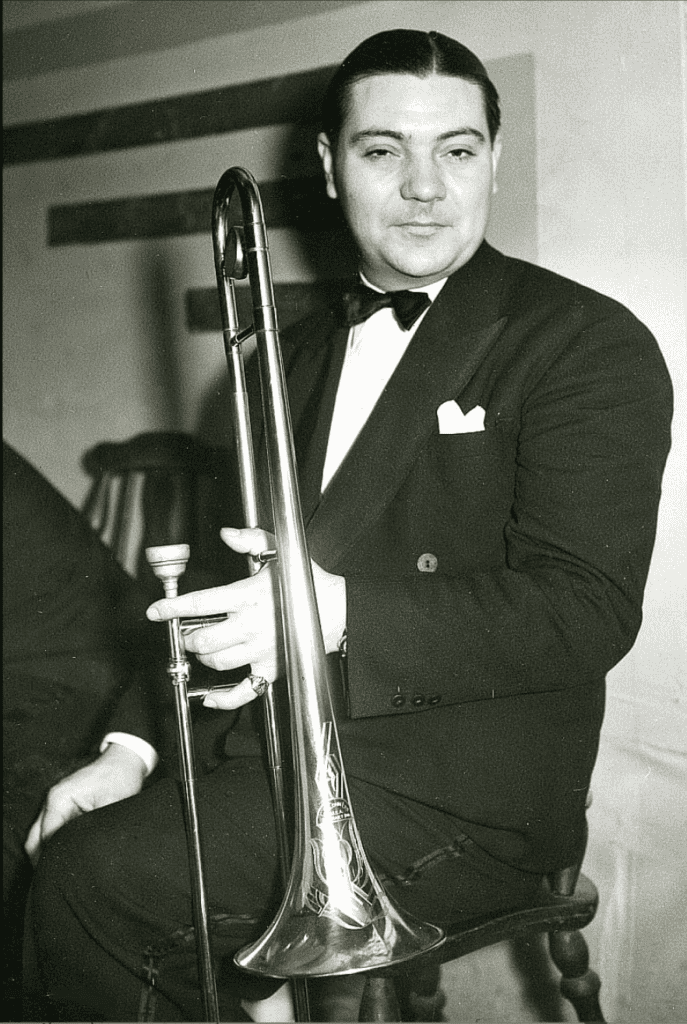
Jack Teagarden was an American jazz trombone player (known for his creative style) before the Bebop era. He traveled around the USA in the mid-1920s, playing with different bands and orchestras.
From 1933 to 1938, he played in the Paul Whiteman Orchestra. After leaving big bands in 1946, he joined Louis Armstrong’s All-Stars band. In late 1951, he left to lead his own band again.
Mr. Teagarden was highly respected as a top jazz player and singer. Some critics (in my opinion) thought he was the best ever on his brass horn. He was among the few jazz musicians (like Louis Armstrong and Duke Ellington) who were true masters.
Ready to start learning? Read my “Trombone Scale Chart PDF — Learn Trombone Scales Fast“!
J. J. Johnson – Greatest Bebop Trombone
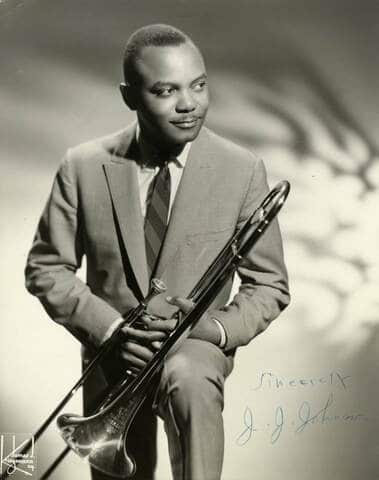
Facts:
- January 22, 1924 – February 4, 2001
- Genres: Jazz, bebop, big band
- Instruments: trombone, piano
- Played trombone for more than 40 years
- “Wee Dot,” “Lament,” and “Enigma” in the Jazz standards list
- Awards:
- Indiana Governor’s Arts Award, 1989
- 4 Grammy nominations
James Louis Johnson (“Jay Jay Johnson”) was an American jazz trombonist, composer, and arranger. He played the slide trombone with amazing speed and ease. He showed that bebop style could work on a slide trombone during his career in the 1940s-1950s.
Johnson started learning piano at age 9 but switched to trombone at 14. He played with Benny Carter’s big band and toured with many bands. He also worked with famous bop musicians. Later, he joined the Jazz Philharmonic Orchestra.
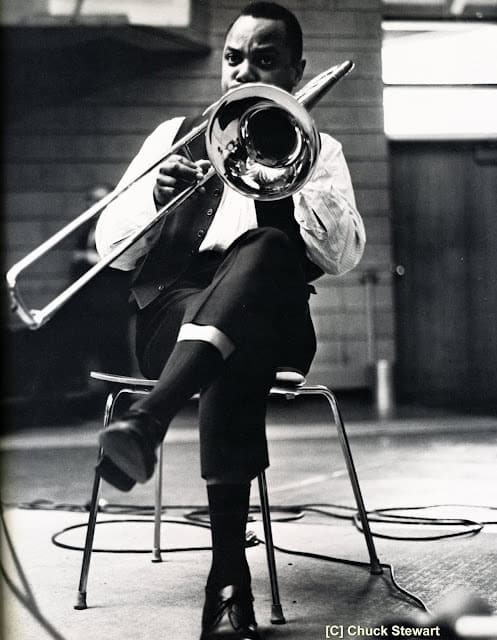
In 1951, Johnson worked as a blueprint inspector while touring military camps in Japan and Korea. In 1954, he found success with Kai Winding in their “Jay and Kai Quintet” project. In the mid-1950s, he led small touring groups with Winding.
From the mid-1950s, Johnson focused more on writing music for jazz festivals, movies, and TV. In the late 1980s, he returned to performing and toured in the United States, Europe, and Japan.
Kai Winding
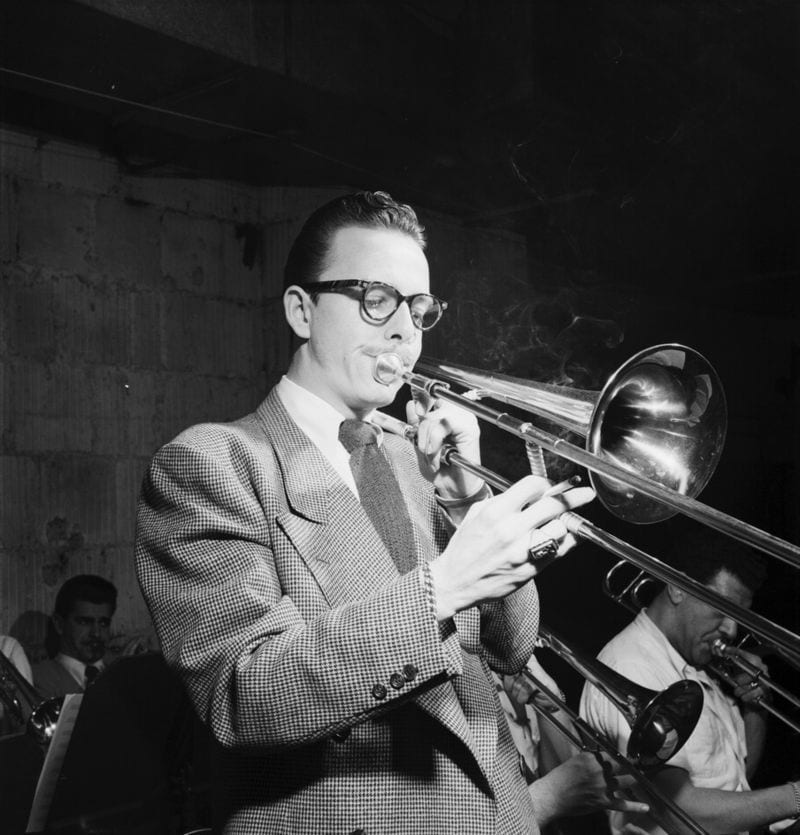
Facts:
- May 18, 1922 – May 6, 1983
- Genres: Jazz
- Instruments: trombone, ondioline (arguable)
- Awards:
- Number 8 on the Billboard Hot 100, 1963
Kai (pronounced like “fly”) Chresten Winding was a respected jazz trombone player in the bebop era. He played early bop music and worked with great jazz piano players. He even joined one of Miles Davis’ famous recording sessions.
His tone wasn’t the best among top trombone players (in my opinion). But he had great style and was amazing at arranging music. He started trying different numbers of horns in his music. Other famous trombone players later used his method.
When Winding was 12 years old, he moved to the U.S. with his family. At 18, he started playing trombone with Shorty Allen’s band. He played in a Coast Guard band for three years. After the war, he joined Benny Goodman’s orchestra.
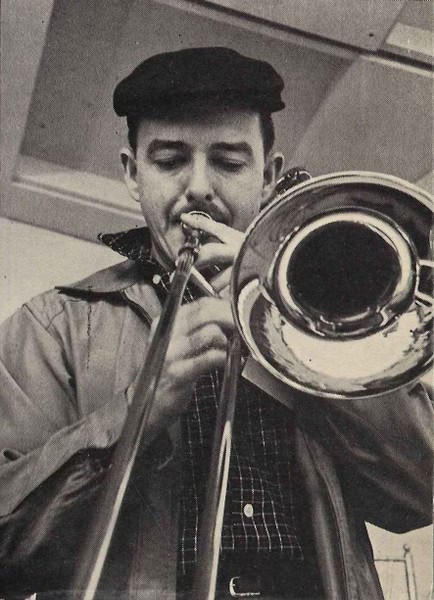
J.J. Johnson was often more famous than Winding. But Kai formed a group with Johnson that became very popular in the mid-1950s. In 1971, Winding joined a special group called Giants of Jazz. His son (Jai Winding) works as a keyboard player, writer, and music producer.
Many of Kai Winding’s recordings aren’t easy to find today. But you can listen to his version of “More” from the movie “Mondo Cane.” This song was very popular and reached number 8 on the Billboard Hot 100 in 1963. This recording shows his skills as a tenor trombone player (and it’s one of the few still available).
Curtis Fuller
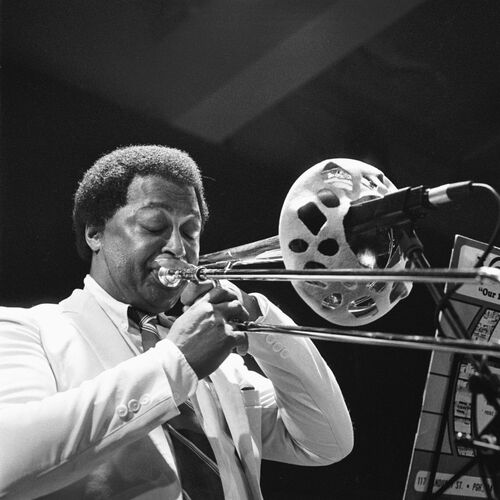
Facts:
- January 22, 1924 – February 4, 2001
- Genres: jazz, bebop, big band
- Instruments: trombone, baritone
- Awards:
- Honorary doctorate of music from Berklee College of Music, 1999
- NEA Jazz Master, 2007
- Member of the School of Jazz Studies, NY
Curtis DuBois Fuller (one of my favorite trombone players) stands out as a top jazz musician. He grew up as an orphan but never let that stop him. His bold solos made him famous in hard-bop music.
Fuller was the first founding member of the Jazztet (a jazz group with six players). His special sound made him different from other trombone players. For a while, he played hard bop with a band that used electronic instruments.
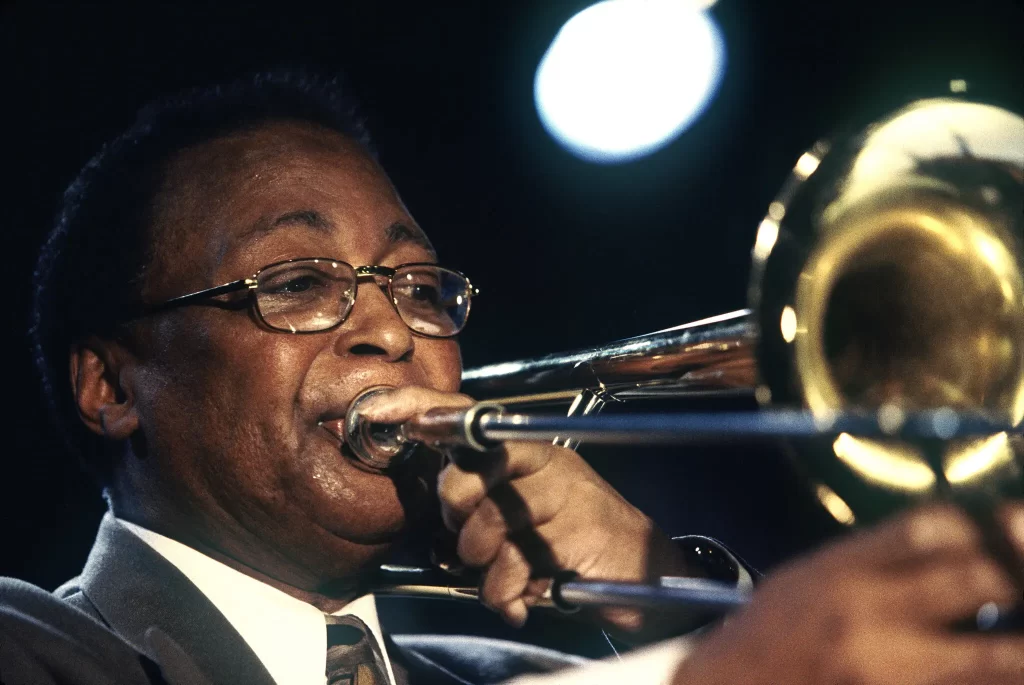
After his time in the army, Fuller joined Yusef Lateef’s group and made two albums. At just 20 years old, he created his famous trombone style. He later recorded albums with Sonny Red (an alto saxophone) and led a group of five musicians.
In the 1980s, Fuller often toured with the Timeless All-Stars. He became highly respected in jazz schools around the world. Fuller shared his knowledge as a teacher at famous schools like Berklee, Harvard, and Stanford (places I wish I could study).
Curtis Fuller’s work as a jazz expert has made him one of the most important people in jazz history (in my opinion).
Slide Hampton
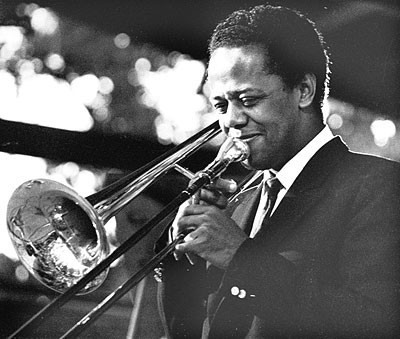
Facts:
- April 21, 1932 – November 18, 2021
- Dedicated 80 years to Jazz
- Genres: Jazz
- Instruments: trombone, tuba, flugelhorn
- Awards:
- Grammy Award for Best Jazz Arrangement, 1998
- Grammy Award for Best Large Jazz Ensemble Album, 2005
- National Endowment for the Art, 2005
Slide Hampton was a great American jazz trombonist. He composed music and arranged songs for jazz bands and pioneered the Jazz big band sound.
He wrote complex harmonies and played with rhythms that created unique musical textures. His songs had social messages — he addressed civil rights and world problems!
Slide was born into a musical family. They needed a trombone player since every other instrument was “covered”. He joined his father’s band at 12 years old. The Hampton Band toured the Midwest, where Slide, as a child, met many jazz stars.
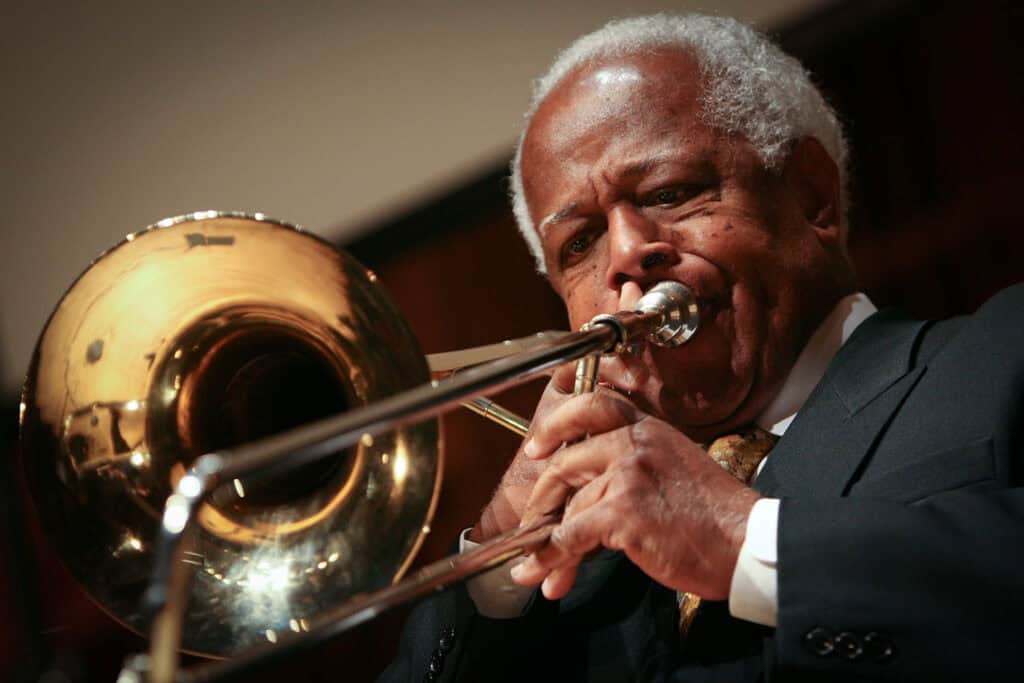
At 20, he joined Maynard Ferguson’s band and even added his own songs to their playlist. After gaining experience, he created the Slide Hampton Octet. His group toured across America and Europe.
Slide worked as a music director for many orchestras. He performed with other jazz greats in Europe, winning two Grammy awards.
Slide Hampton made many albums. He arranged music for other musicians and wrote music for TV shows. He even taught master classes at Harvard.
Tricky Sam Nanton
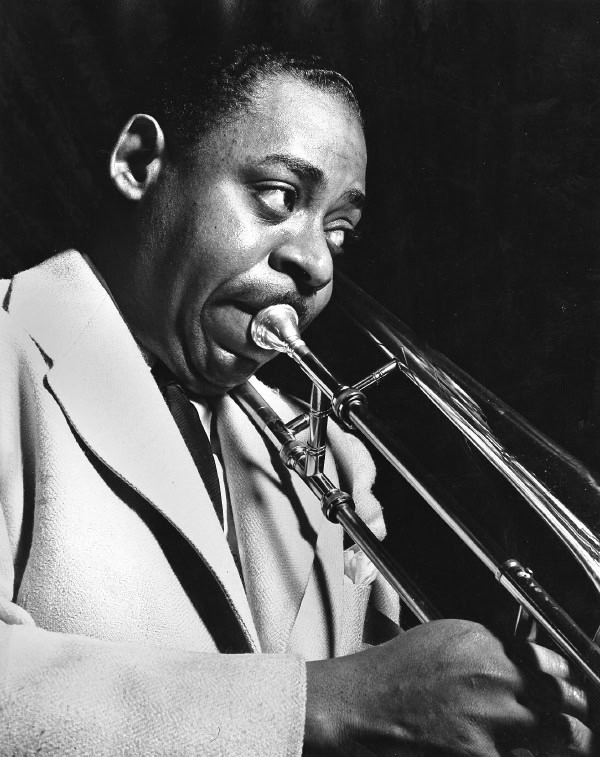
Facts:
- February 1, 1904 – July 20, 1946
- Genres: Jazz, swing
- Instruments: trombone, trumpet, piano
- Pioneer of trumpet and trombone “wah-wah” sound
- Awards:
- Inducted into Big Band and Jazz Hall of Fame, 1993
Joe “Tricky Sam” Nanton was an American diamond among famous trombone players. He had a unique style with growling notes and mutes to create interesting sounds. His heavy mute work and fast fingering earned him the nickname “Tricky Sam.” He played with Duke Ellington from 1930 to 1942.
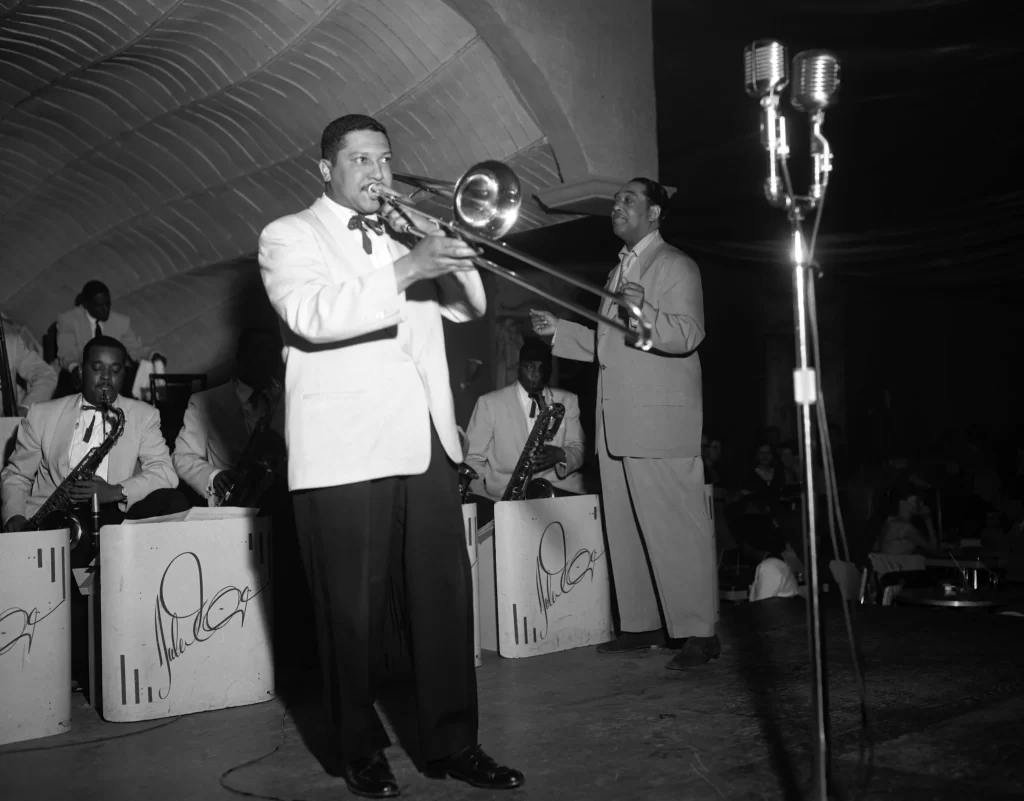
Nanton was born in New York and started music at age 10. He was an important jazz musician who made the plunger mute popular. This device created a special wah-wah sound. Joe could also hit high notes on the trombone. After leaving Ellington, he played with other jazz groups until he died in 1946.
Joe Nanton taught younger musicians like Clark Terry and Booty Wood. He helped create a new style of music that had a big impact. Joe Nanton is remembered as one of the greatest jazz trombonists ever.
Glenn Miller
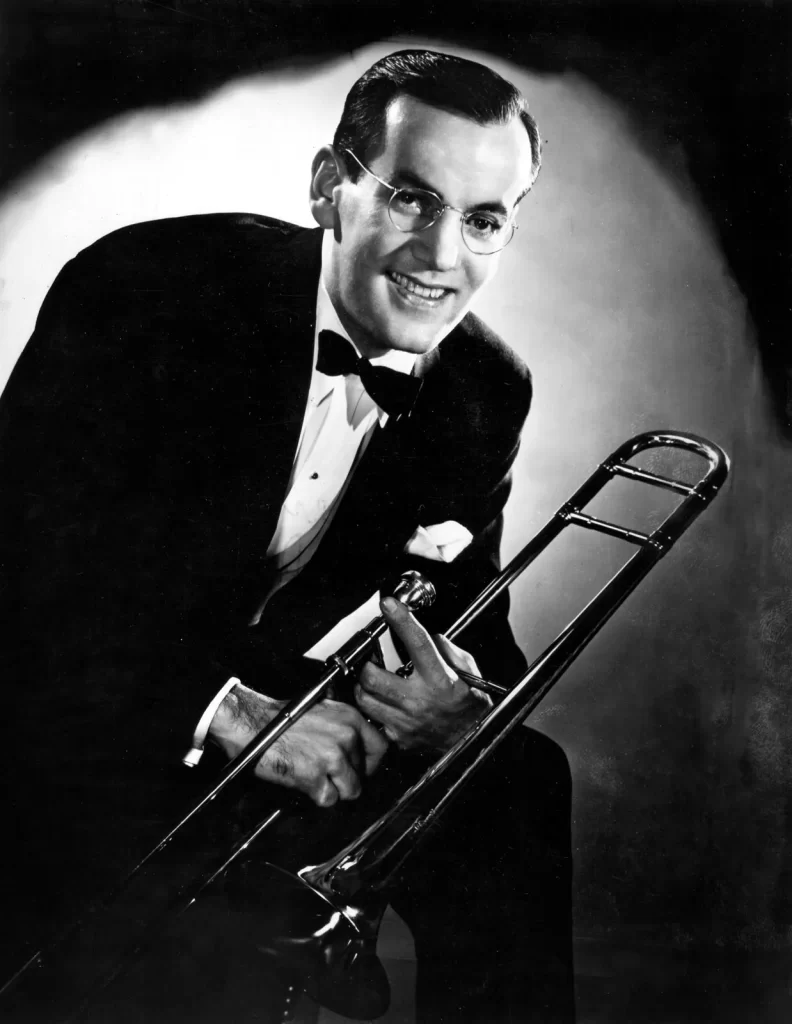
Facts:
- March 1, 1904 – December 15, 1944
- Genres: swing, big band
- Instruments: trombone, cornet, mandoline
- Awards:
- Three recordings into the Grammy Hall of Fame
- Five military awards, including Bronze Star Medal
- Star for Recording on the Hollywood Walk of Fame
Glenn Miller was an American jazz musician. He led a famous band in the 1930s and 1940s during the “swing era.”
Miller’s band was very popular. They played songs many still know today, like “Moonlight Serenade” and “In the Mood.”
Miller started playing music in the 1920s. He formed his own band in 1937. His music became very famous from 1939 to 1943 as soldiers in World War II really liked his music.
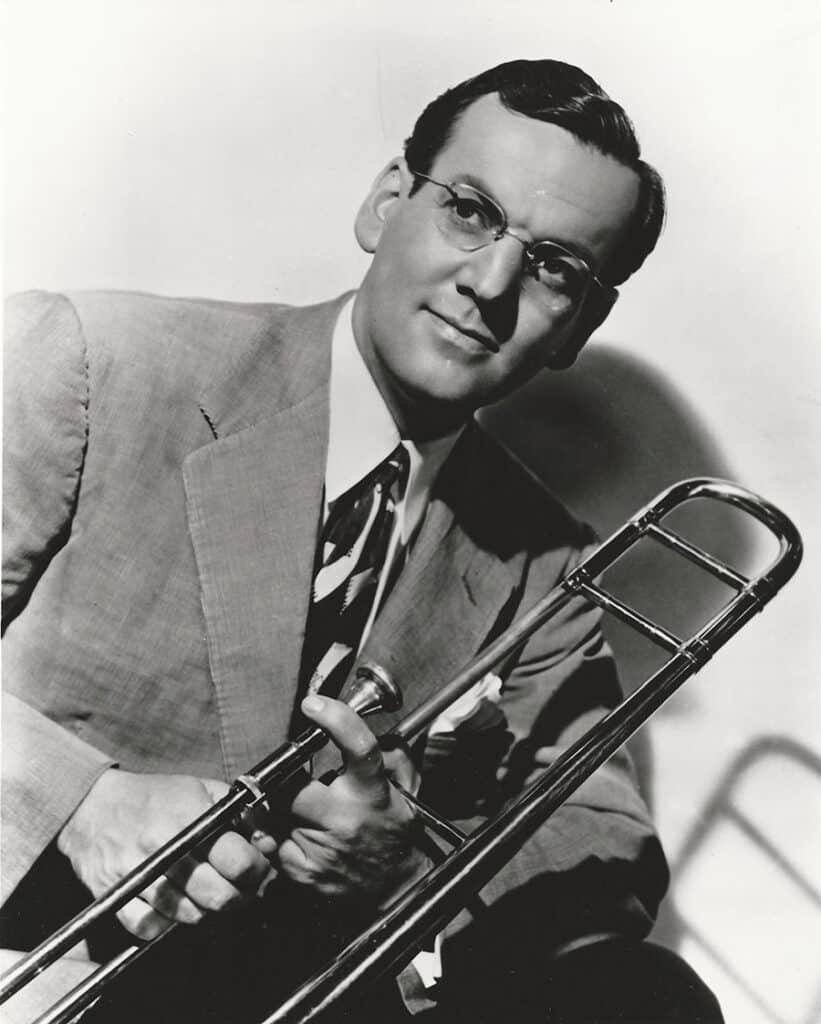
In 1943, Miller joined the Army. He made music for the troops. Sadly, his plane went missing in 1944. He was only 40 years old.
Miller was good at playing the trombone in a new way. He also wrote music for other trombone players. His style of music was called “swing.”
Many people still love Miller’s music today. He won awards even after he died and was put in the Alabama Jazz Hall of Fame. His songs are still played around the world!!
Bob Brookmeyer
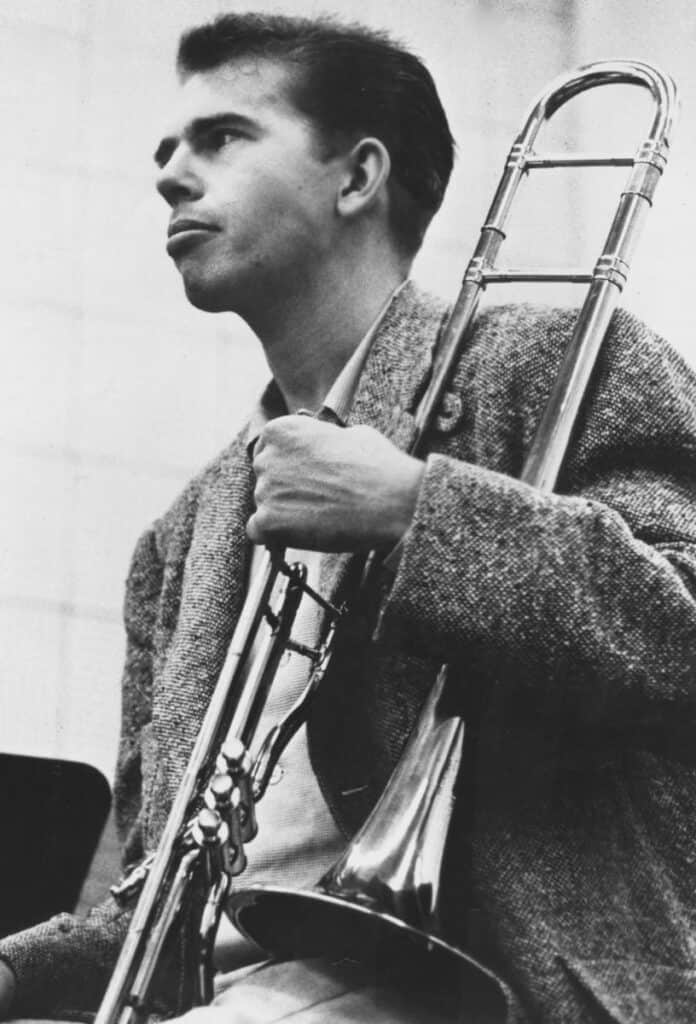
Facts:
- December 19, 1929 – December 15, 2011
- Genres: Jazz, post-bop
- Instruments: valve trombone, piano
- Awards:
- Nine Grammy nominations, 1960-2011
- National Endowment for the Arts Jazz Master, 2006
Bob Brookmeyer was a big name in jazz. He played the valve trombone. He grew up in Kansas City, Missouri.
Bob started playing in big bands in the late 1940s. He worked with many famous jazz stars. Some of my favorites were Miles Davis and Thelonious Monk.
In 1958, Bob made his first album as a leader. He kept touring and recording for many years. His style mixed modern jazz with swing.
Bob’s music inspired many other artists. He also wrote music for singers like Carmen McRae.
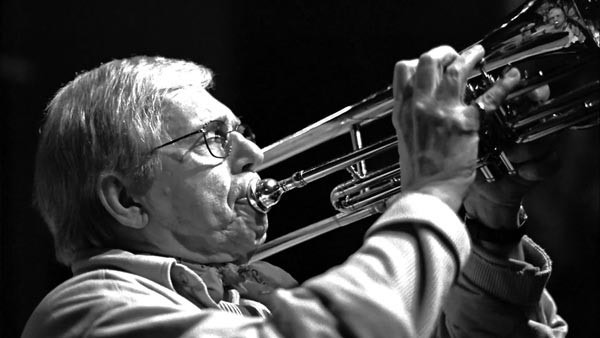
In the 1980s, Bob focused on writing music and leading big bands. He was the first artist to record with Verve Records.
Bob was not just a great player. He was also a teacher and mentor. He helped many young jazz musicians.
Bob passed away in 2011 at 81 years old. But his music lives on. He will always be remembered as a jazz great.
If you’re interested in valve trombones, we’ve compiled a list of the “Best Valved Trombone: 7 Models of Top Brands“.
Juan Tizol
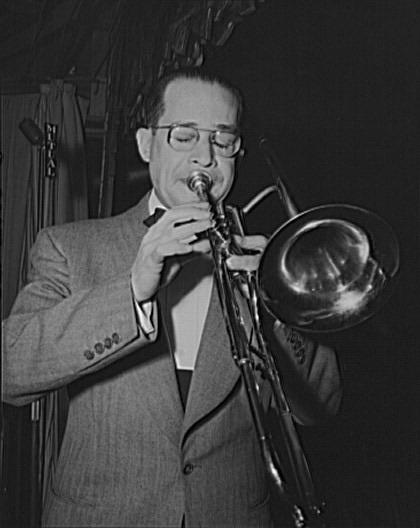
Facts:
- January 22, 1900 – April 23, 1984
- Genres: jazz, bebop, big band
- Instruments: valve trombone, violin as the first instrument
- Worked 15 years in a famous Jazz Orchestra
- Composed legendary Caravan
Juan Tizol was a famous musician from Puerto Rico. He played the valve trombone and wrote music. He worked with Duke Ellington from 1929 to 1944.
Tizol wrote some of Ellington’s best-known songs. These include “Caravan” and “Perdido.” Many people think he wrote “Take the ‘A’ Train” too, but that’s incorrect!
After leaving Ellington’s band, Tizol led his own groups in New York City. He also wrote music for TV shows. You might know some of these shows, like “The Man from U.N.C.L.E.”
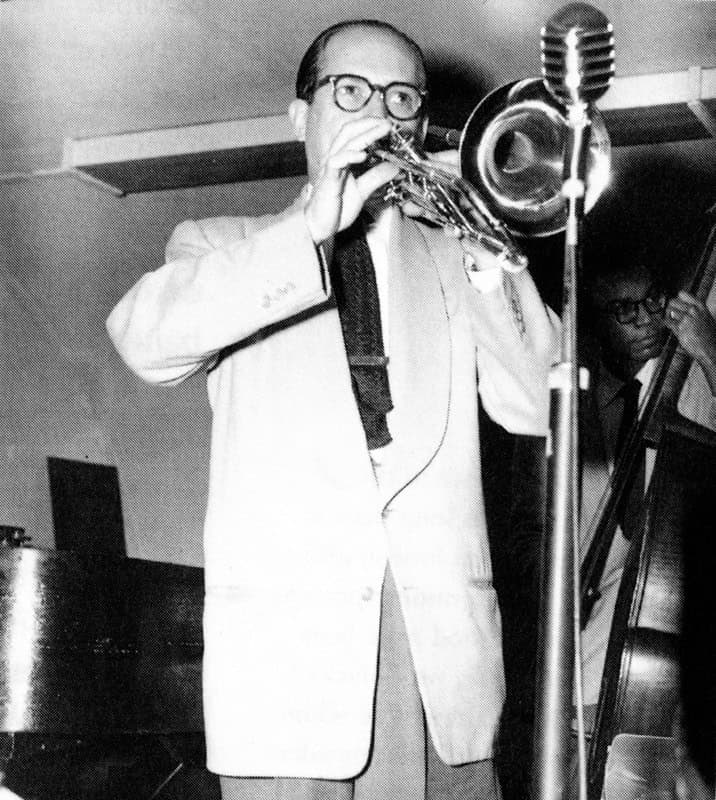
Tizol was born in San Juan. He started playing music when he was 11 years old. Later, he moved to New York City to study music.
In 1929, Tizol joined Duke Ellington’s band. He became a very important member. His playing and writing helped create the band’s special sound.
Tizol’s music is still important today. Many think he was one of the best trombone players ever. He died in 1984, but his music lives on.
Learn more about “What is a Tenor Trombone: Range, Parts, Best Models” in my post!!
Wayne Henderson
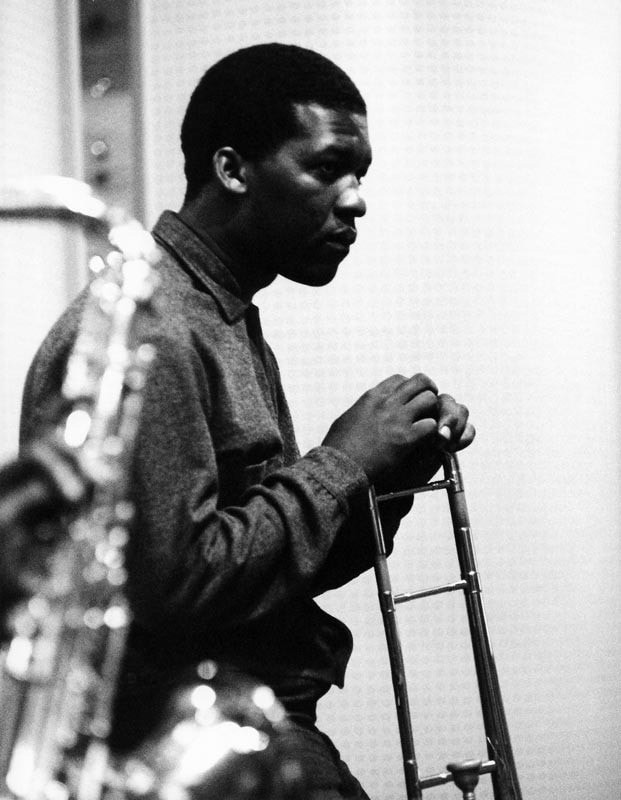
Facts:
- September 24, 1939 – April 5, 2014
- Genres: Soul, hard bop
- Instruments: trombone
- Played trombone professionally for 40 years
- Awards:
- Grammy nomination
Wayne Henderson (born in Houston, Texas) is a skilled trombone player. He is one of the first members of The Jazz Crusaders.
He learned trombone as a young person. He studied jazz with Don Menza at the University of Southern California. Wayne plays many styles well, mainly jazz, soul, and hard bop. He has worked with famous artists like Herbie Hancock, Freddie Hubbard, and Stanley Clarke.
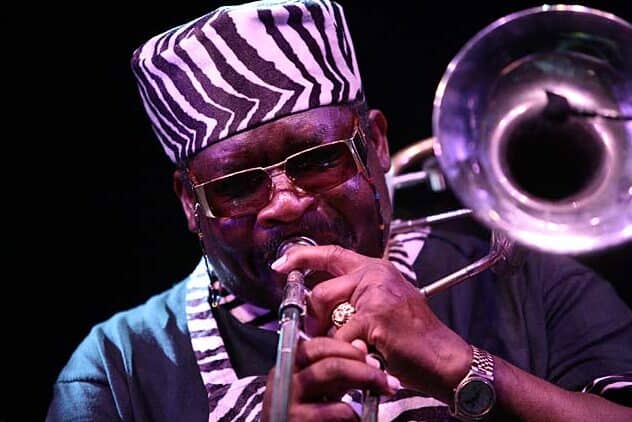
Henderson formed The Jazz Crusaders in 1961. He started the group with Wilton Felder, Joe Sample, and Stix Hooper. The group found success in jazz, pop, and funk music. They released many praised albums on Pacific Jazz and Blue Thumb Records. He earned a Grammy nomination for “Rhapsody and Blues” (a song on their 1975 album Scratch).
After The Jazz Crusaders, Henderson worked with many other artists. These included Diana Ross, Bill Withers, and Aretha Franklin. He has released several solo albums, too.
Wayne Henderson still performs live with his own band. His 1995 album (Trom Bone Bone) came out on Capitol Records. He has also taught at the University of Southern California.
Julian Priester
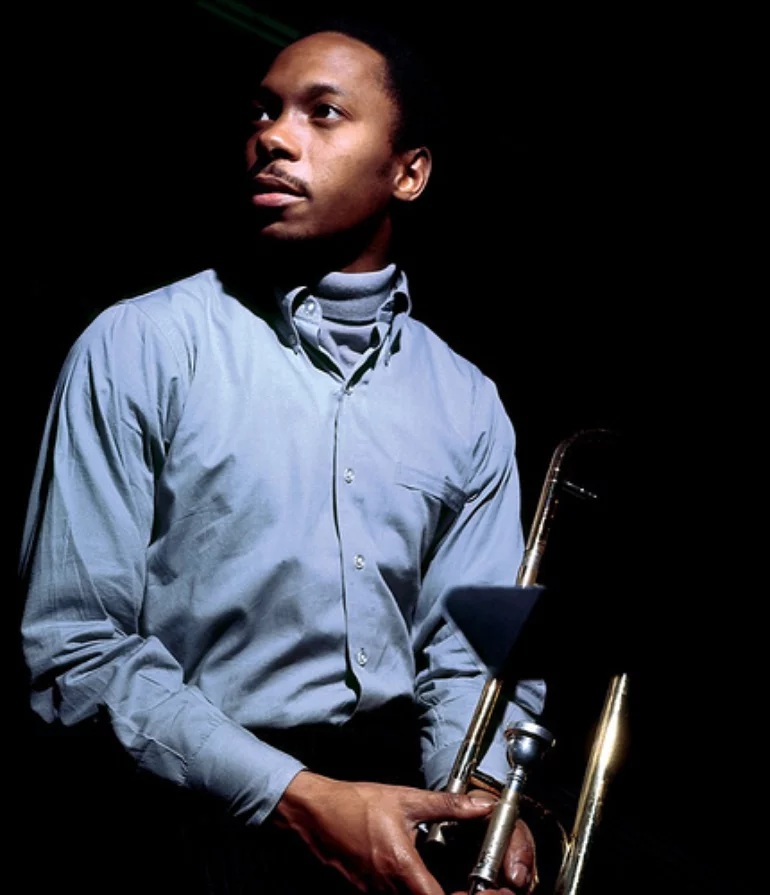
Facts:
- June 29, 1935
- Genres: Jazz
- Instruments: trombone, euphonium
- Awards:
- The Golden Ear Awards, 2016
- Seattle’s Jazz Hero, 2013
Julian Priester is an American jazz trombonist and composer who was born in 1935 in Chicago. He started playing trombone as a child. He went to DuSable High School. The school had a famous jazz band with Sonny Rollins. He studied at the Chicago Conservatory of Music. Then, he joined Sun Ra’s big band in 1954.
In the 1960s and 1970s, Priester played with top jazz artists. He worked with John Coltrane, Art Blakey, and McCoy Tyner — all big names in jazz. He was in the jazz-rock fusion band Weather Report from 1971 to 1977. With them, he made three albums: “I Sing the Body Electric,” “Sweetnighter,” and “Heavy Weather.”
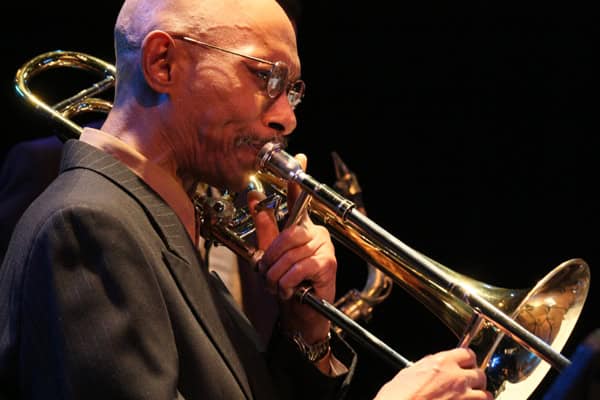
Priester formed a group called Totem with other jazz musicians (like Malachi Favors and Don Moye). He also made solo albums. These include “Love, Love,” “Polarization,” and “Spirit of the Horn”.
Julian Priester is now 87 years old. He still performs at major jazz festivals. He teaches music in Seattle today. He has been added to the Seattle Jazz Hall of Fame. He is a master trombonist whose playing has inspired many.
Roswell Rudd
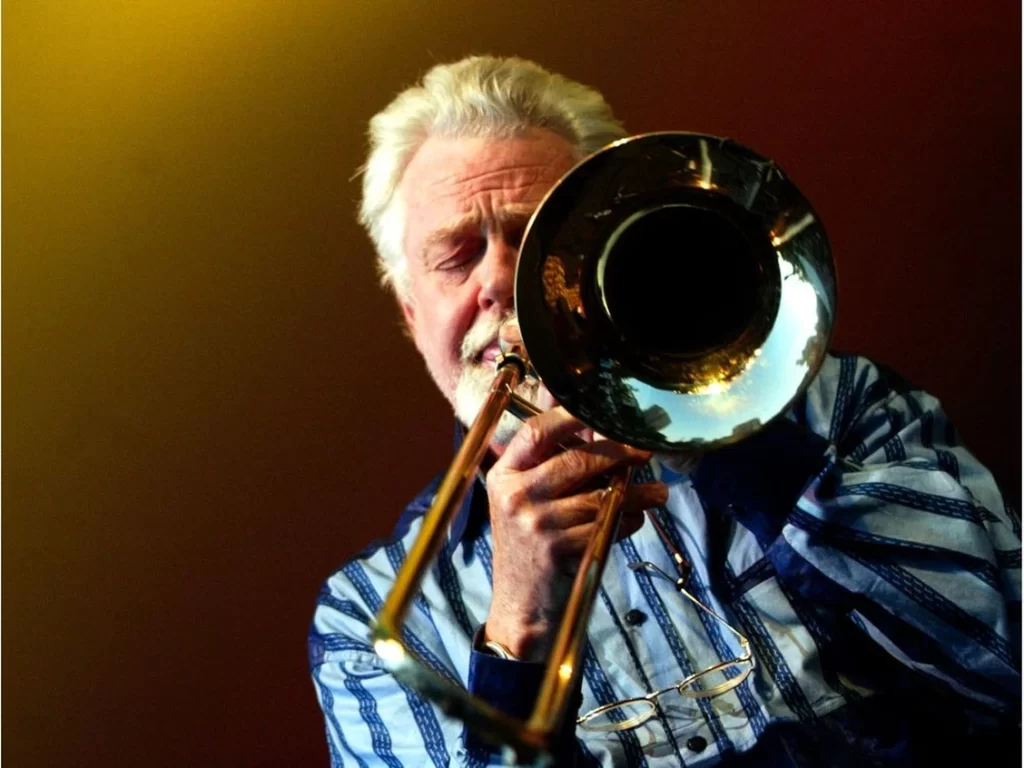
Facts:
- 17 November 1935 – 21 December 2017
- Genres: Avant-garde jazz
- Instruments: trombone, piano
- Awards:
- Grammy Award for Best Vocal Performance Male and Best Jazz Instrumental Album, Monk’s Dream (1999)
- Trombonist of the Year by Jazz Journalists Association, 2003-2005, 2009-2010
Roswell Rudd was a jazz trombonist known for his special style. He started learning music when he was young.
He got a music degree from Yale University in 1953. He played with other students who later became famous jazz musicians.
After college, he worked in New York City’s jazz scene. He played with avant-garde musicians like Archie Shepp, Sun Ra, and Cecil Taylor.
Rudd also played in Europe and Asia. He made more than 20 albums as a leader or co-leader.
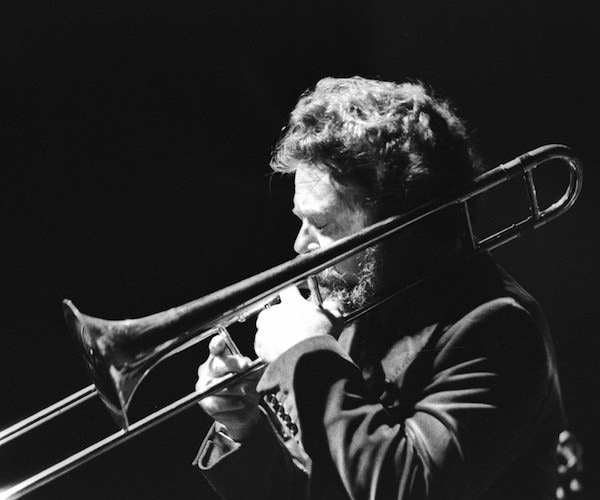
His most famous works include ‘Trombone For Lovers’ from 2013 and ‘Monk’s Dream’ from 2000 (this one won a Grammy Award). He also wrote music for films, plays, and TV shows.
Rudd changed jazz trombone playing. He played more lyrical solos instead of the loud, brassy style most people used.
He created a new way to make vibrato sounds on the trombone. He did this by moving his lips and controlling his breath in a unique way.
Rudd helped start the jazz avant-garde movement . He was a founding member of the Jazz Composers’ Guild, a group of musicians who wanted to make experimental music more popular.
Bill Watrous
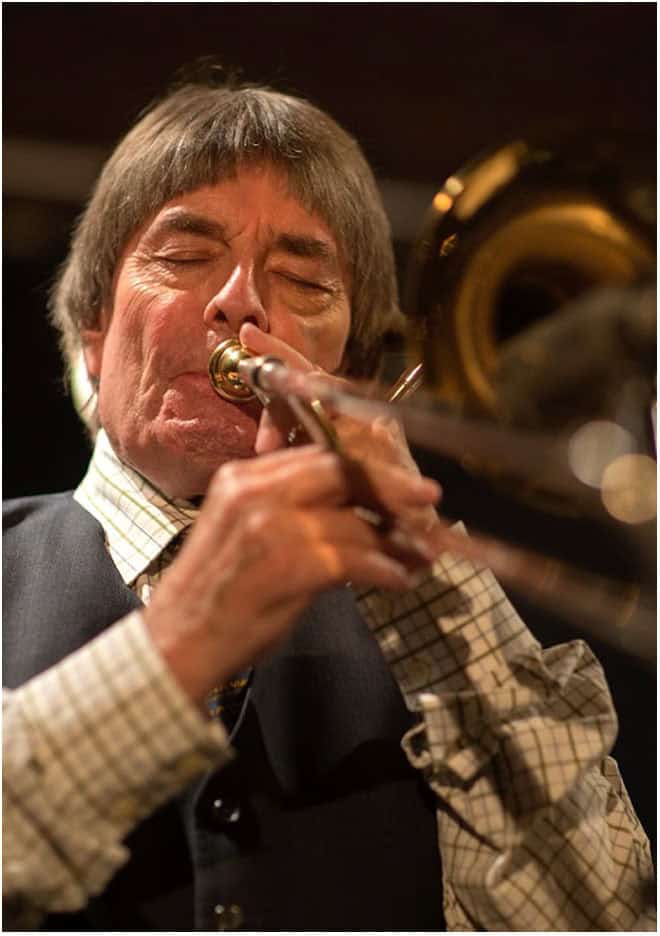
Facts:
- June 8, 1939 – July 2, 2018
- Genres: Jazz
- Instruments: trombone, piano
- Played in New York Yankees
- Awards:
- Grammy Nomination, 1975
- The Legacy Circle Award, 2019
Bill Watrous was an American jazz trombonist. He was born in Middletown, Connecticut. His father — a professional trombonist — introduced him to the jazz trombone world during childhood.
With his friendship with jazz pianist Herbie Nichols, Watrous learned about bebop, modern jazz, and jazz improvisation. In the early 60s, he became a full-time musician after playing in semi-professional bands and studying with Herbie Nichols.
Watrous played in bands led by Billy Butterfield, Kai Winding, Maynard Ferguson, and Woody Herman. He also recorded with studio groups and big bands (including Quincy Jones). While working with Kai Winding’s groups, he also worked as a broadcasting staff musician for CBS and joined Merv Griffin’s TV show orchestra.
Learning trombone theory? I made the “Trombone First Steps — Learn Trombone Slide Chart PDF” guide with downloadable materials.
Arthur Pryor
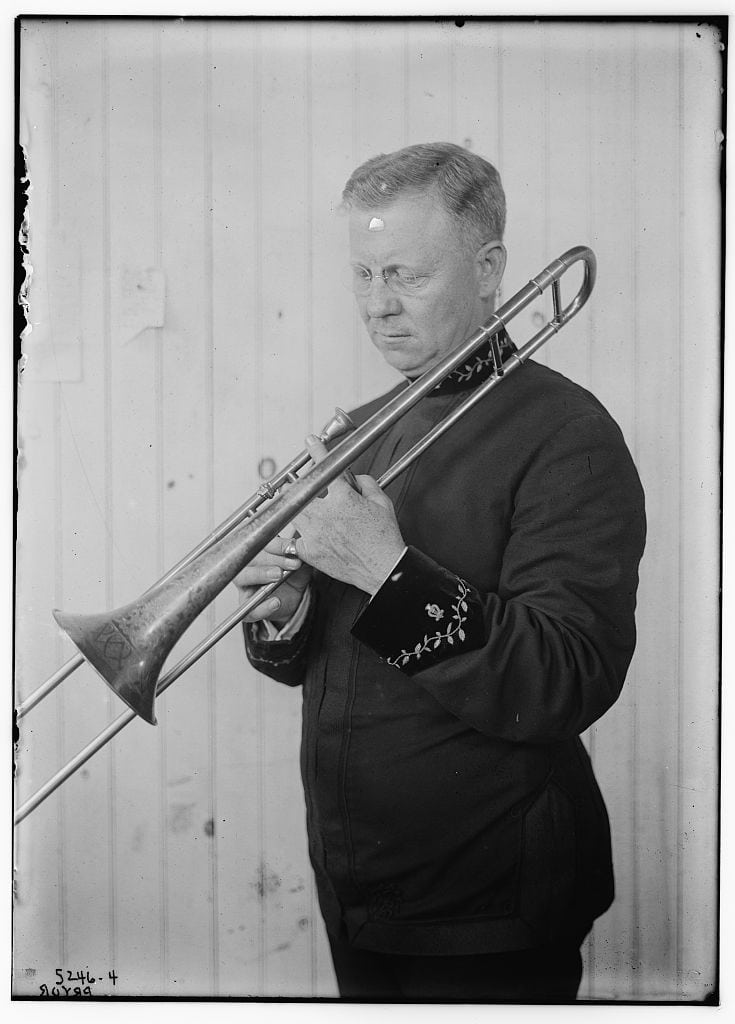
Facts:
- September 22, 1869 – June 18, 1942
- Genres: Jazz
- Instruments: trombone, piano, piccolo
- Wrote and arranged one of the most famous trombone pieces, “Bluebells of Scotland”
Arthur Pryor was a talented American musician. He played the trombone, led bands, and wrote music.
Pryor was born in St. Joseph, Missouri. As a kid, he learned to play the piano and brass.
His skills got him a special invite. He joined the John Philip Sousa Band of Marines in Washington, D.C.

Pryor then started his own band. He wrote over 350 pieces of music. He helped other musicians too, like Harry James.
His music helped shape jazz. Pryor played his songs in many places. You could hear him in vaudeville shows, on the radio, and even in silent movies!
Carl Fontana

Facts:
- July 18, 1928 – October 9, 2003
- Genres: Jazz
- Instruments: trombone
Carl Fontana (born in Monroe, Louisiana) was a jazz trombonist. His father, Collie Fontana, was a musician and taught him to play. By high school, Carl played in his father’s band. He also loved sports: football, basketball, baseball.
He studied music at Louisiana State University. In 1950, he graduated and soon got his big break. Woody Herman needed a trombonist, and Carl filled in. He impressed everyone and got the job.
Carl played with Stan Kenton, Lionel Hampton, and many Vegas bands. He backed up stars like Sammy Davis Jr. and Tony Bennett. His first solo album, “The Great Fontana,” came in 1985.
His style was smooth, with fast, clean notes (his “doodle tonguing” was legendary). Many jazz musicians say he was underrated. He also taught young musicians.
Carl recorded over 70 albums but didn’t release his own album until 1985 (“The Great Fontana”). He passed away in Las Vegas (on October 9, 2003), leaving behind an amazing jazz legacy.
Elliot Mason

Facts:
- January 13, 1977
- Genres: Jazz
- Instruments: trombone, keyboard, bass trumpet
Elliot Mason is a jazz trombonist known for his technical skill and unique sound. His father introduced him to the trumpet at age four, but by seven, he switched to the trombone. By eleven, he was performing in clubs, and by fifteen, he won the Daily Telegraph Young Jazz Soloist Award.
At sixteen, he earned a full scholarship to Berklee College of Music in Boston. There, he studied under Hal Crook and Phil Wilson. During college, he won the Frank Rosolino Award and the International Trombone Workshop’s jazz competition. After graduating, he moved to New York City, where his career took off.
He joined the Jazz at Lincoln Center Orchestra in 2007, playing under Wynton Marsalis. He has performed with Paul Simon, Willie Nelson, and the Count Basie Orchestra. His projects include the Mason Brothers Quintet and his solo album “Before, Now & After”.
As an educator, he has taught at Berklee, Northwestern, and Juilliard. His students admire his innovative approach to jazz. Critics love his “monster technique” and “exquisite taste.”
Albert Mangelsdorff
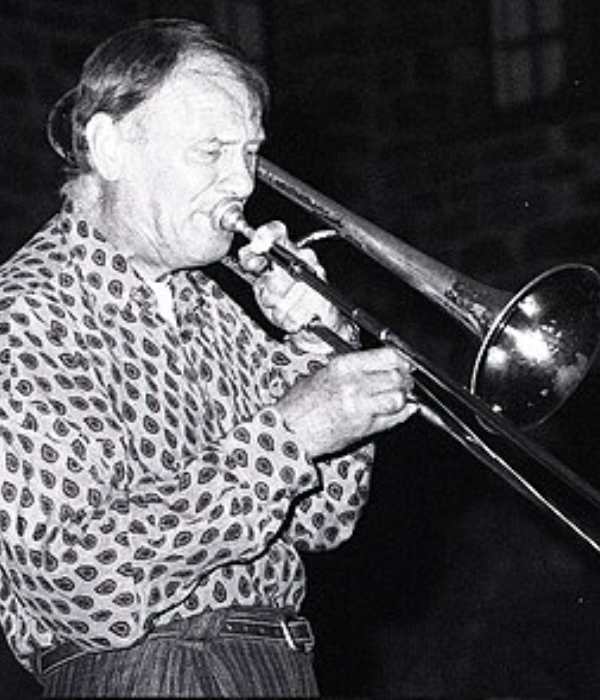
Facts:
- September 5, 1928 – July 25, 2005
- Genres: Jazz
- Instruments: trombone, violin, guitar
Albert Mangelsdorff (German jazz legend) was born in 1928 in Frankfurt, Germany. He started with violin and guitar before finding the trombone.
After World War II, he played in US Army clubs. His brother Emil introduced him to jazz records. Albert learned trombone techniques from Fritz Stähr.
He became famous in the 1950s. In 1958, he played at the Newport Jazz Festival. His Albert Mangelsdorff Quintet (formed in 1961) became very popular.
Mangelsdorff invented multiphonics — this technique changed trombone playing forever!!
He won many awards and taught at Frankfurt University. The Albert Mangelsdorff Prize (worth 15,000 Euros) honors top jazz musicians today.
He died in 2005, but his music lives on. Many fans still call him “the number one trombonist in the world.”
Eje Thelin
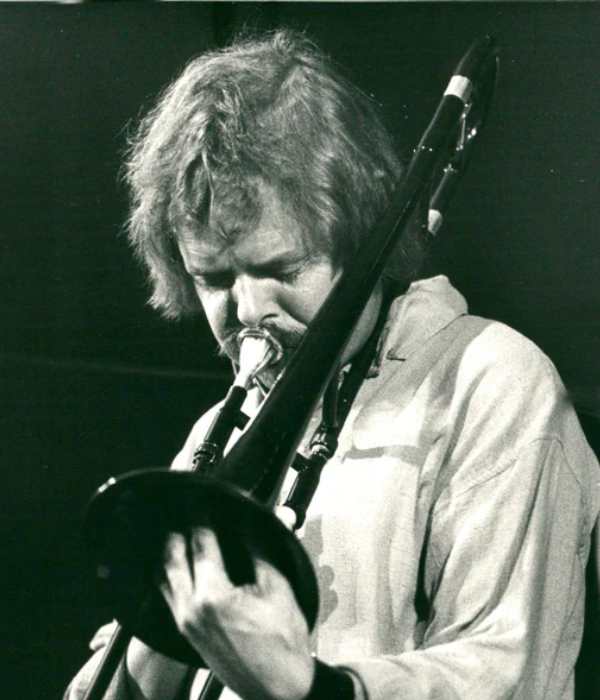
Facts:
- 9 June 1938 – 18 May 1990
- Genres: Jazz
- Instruments: trombone
Eje Thelin taught himself to play trombone. He started with the Pygmé Jazz Band before joining Putte Wickman’s sextet.
In 1961, Thelin formed his own quintet. They toured Europe and made many recordings (like “So Far” and “At The German Jazz Festival”). He moved to Austria in 1968 to teach music and play with Joachim Kühn.
Thelin returned to Sweden in 1972. He created the Eje Thelin Group and changed his style to include electronic sounds. His music went from traditional jazz to modern styles, including free jazz and fusion.
He worked with many famous musicians: Roy Brooks, George Russell, and Kenny Wheeler. Thelin made albums as a leader (“Acoustic Space”) and played on others’ recordings (Don Cherry’s “Eternal Rhythm”).
Eje Thelin died on May 18, 1990. His creative approach to trombone playing still inspires jazz musicians today.
The Swing Era – the Big Bang
The swing era (also known as the big band era) was popular in America from the 1920s to 1940s. It was a time when swing music had a strong impact.
Big band music came from mixing styles like ragtime, blues, and European folk music. These bands used many instruments to create their sound.
Jazz bands often had saxophones, brass horns, pianos, and rhythm sections. Their music topped the pop charts during this time.
Swing got more popular as people created new dances for its lively beat. Young Americans loved this new music and the famous Lindy Hop dance.
As radio stations grew and people wanted exciting music, swing became popular. It became more popular than other music styles (including regular jazz).
Bebop Jazz
Bebop is a type of jazz that started in the 1940s (in my opinion, one of the most exciting periods in music). It spread all over the United States. Bebop has a fast beat and tricky music patterns.
Players made up music on the spot in Bebop. The style came from hard bop (an older jazz type). Hard bop used blues and swing sounds.
The trombone helped Bebop become popular. Trombones were in jazz for a long time. But trombone players like (J.J. Johnson and Kai Winding) made the trombone sound special in bebop.
These trombone players used new ways to play. They did flutter-tonguing, overflowing, and growling. These tricks made a strong sound.
Small bebop bands changed jazz forever. Their sound shows up in funk, fusion, and hip-hop today. Bebop still shapes modern music. The trombone played a big part in this change.
Are you ready to start learning the trombone? Check out our Top 7 Beginner and Student Trombones under $1500 in 2023.






